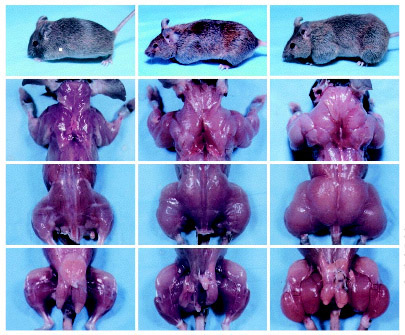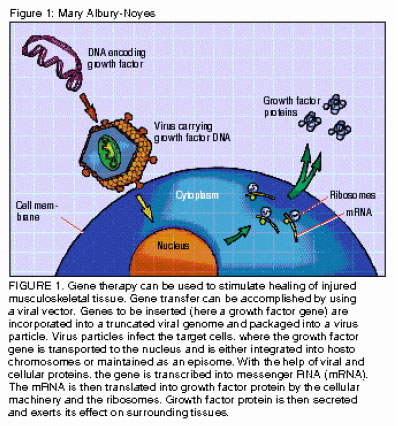Na pierwszym planie pozwolę sobie wrzucić trochę info odnośnie dopingu genetycznego z różnych źródeł co miałoby na celu lekko objaśnić jak to wygląda laikom tematu.
NIECZYSTE ZAGRANIE
(źródło: Rzeczpospolita)
ZOZ BAŁUTY OSTRZEGA I ZAKAZUJE STOSOWANIA!
Rywalizacja o sportowe medale już dawno przeniosła się z boisk i bieżni do laboratoriów naukowych. Środki dopingujące pozwalają na podniesienie wydolności organizmu i przyrost masy mięśniowej, jednak za cenę chorób układu krążenia, zaburzeń hormonalnych i innych dolegliwości.
Doping dzieli się na farmakologiczny i genetyczny.
Doping farmakologiczny:
* sterydy anaboliczne - syntetyczne wersje męskiego hormonu - testosteronu. Zalicza się do nich: THG (tetrahydrogestrinon), clenbuterol, nandrolon, stanazolol. Umożliwiają wzrost masy mięśniowej i siły. Powodują wzrost agresji i zmniejszają zmęczenie podczas treningu. Zastosowanie: sporty siłowe takie jak sprinty czy podnoszenie ciężarów.
* hormony peptydowe - erytropoetyna (EPO), hormon wzrostu (HGH), insulina. EPO umożliwia szybszy transport tlenu we krwi - w konsekwencji większy i dłuższy wysiłek sportowy. HGH wspomaga spalanie tłuszczu i wzrost mięśni. Zastosowanie: sporty wytrzymałościowe, takie jak wioślorstwo, kolarstwo, biegi długodystansowe.
* kortykosteroidy np. hydrokortyzon. Redukują stany zapalne przy kontuzjach ściengien. Zastosowanie: niektóre sporty siłowe, baseball, rzut oszczepem, gimnastyka, zapasy.
* narkotyki, opiumaty: diamorfina (heroina), metadon, morfina, petydyna, marihuana. Zwiększa odporność na ból, relaksują. Zastosowanie: pływanie, biegi długodystansowe.
* beta-blokery: acebutolol, alprenonol, nadolol, propranolol. Zmniejszają częstotliwość pracy serca i ciśnienie krwi, redukują drżenie mięśni. Zabronione w łucznictwie, gimnastyce, pięcioboju nowoczesnym, strzelnictwie, pływaniu, zapasach.
Doping genetyczny - wprowadzenie do komórek mięśni odpowiedniej informacji genetycznej np. za pomocą nieszkodliwego wirusa. Cały proces odbywać się może w laboratorium.
Skutki uboczne dopingu:
* łysienie,
* owłosienie twarzy (kobiety),
* powiększenie piersi (mężczyźni),
* uszkodzenia nerek i wątroby,
* skurcze jąder, impotencja,
* nadmierny wzrost narządów,
* szorstkość skóry,
* odnowienia kontuzji,
* problemy oddechowe,
* uzależnienie,
* mdłości,
* cukrzyca,
* jaskra,
* utrata mięśni,
* nadciśnienie.
Tutaj fragment z gazeta.pl
..Pekin: igrzyska mutantów?
A już niedługo pojawi się nowy wróg czystej sportowej rywalizacji, przy którym testosteron czy popularne w ostatnich latach EPO będą jawić się jako preparat witaminowy. Wielkimi krokami zbliża się bowiem era dopingu genetycznego, który z przeciętnego zawodnika będzie w stanie zrobić superistotę. Jak? Dzięki ingerencji w kod genetyczny (np. wszczepianie obcych tkanek czy podawanie specjalnych wirusów) możliwa będzie nadludzka siła i wytrzymałość, a zmodyfikowane ścięgna zniosą każdy wysiłek.
- To jest prawdziwy problem. Sportowiec wspomagający się farmakologicznie prędzej czy później wpadnie w trakcie kontroli. W przypadku dopingu genetycznego nie ma takiej gwarancji - uważa trener polskich 400-metrowców Józef Lisowski.
Według specjalistów w wykryciu takiego rodzaju dopingu bezużyteczne okazać mogą się nawet testy DNA czy biopsja mięśni, a pierwsze efekty ulepszania genów zobaczymy już za dwa lata na igrzyskach w Pekinie. Właśnie gospodarze najbliższej olimpiady oraz Amerykanie uchodzą za liderów w pracach nad dopingiem genetycznym. Nie ma się czemu dziwić. Chińczycy mogą liczyć na gigantyczne sumy od władz, które będą chciały pokazać światu, kto jest najszybszy i najsilniejszy. W Stanach Zjednoczonych pełną parą pracują laboratoria podobne do tych, jakimi dysponowała firma BALCO. To właśnie ona wyprodukowała THG, środek przez wiele lat niemożliwy do wykrycia. Zażywały go takie tuzy sportu jak Marion Jones, Tim Montgomery czy wspomniany Bonds. W obu przypadkach wszystko odbywa się w oparciu o technologię rodem z filmów science-fiction.
- Nawet WADA niewiele może tutaj zdziałać. Najgorsze, że niewiele wiemy na ten temat. Opieramy się tylko na domysłach i przypuszczeniach - opowiada Dariusz Błachnio z polskiej komisji antydopingowej. - Na razie nie słyszałem, by wspomaganie genetyczne wykorzystano w "normalnej" medycynie. Jedno jest pewne, jeśli doping genetyczny się pojawi, będzie to istna apokalipsa w sporcie..
to wziete z poradnikmedyczny.pl
..Coraz częściej w terapii wykorzystuje się mechanizmy genetyczne, uderzając bezpośrednio w przyczynę choroby. Jest to prawdopodobnie najsilniej wspierana badaniami dziedzina medycyny. Kariera genetycznych eksperymentów zaczyna także rozwijać się w sportowym świecie. Klasyczne metody dopingu wychodzą już z mody. Przyszłością jest genetyczny doping, którego największą zaletą, a dla innych oczywistą wadą jest trudość w jego ujawnieniu i kontroli.
Francuscy naukowcy próbują rozwiązać problem wykrywania genetycznego dopingu. Na chwilę obecną nie istnieją takie metody, ale ukazanie wielkości problemu może w niedalekiej przyszłości zaowocować skutecznymi testami. Wykrycie syntetycznej erytropoetyny w organizmie człowieka nie stanowi wielkiego wyzwania dla testów antydopingowych, ale w jaki sposób ujawnić stosowanie "zastrzyków" z genami dla tego enzymu? Choć na razie tego rodzaju doping nie jest powszechnie stosowany to z pewnością w niedalekiej przyszłości problem stanie się codziennością w rywalizacji sportowej.
Dotychczasowe badania na zwierzętach pokazują, że stosowanie genów EPO powoduje niezahamowaną proliferację komórek lini czerwonokrwinkowej prowadząc do licznych zakrzepów, ogólnoustojowej odpowiedzi alergicznej, a w efekcie szybkiego zgonu. Takie powikłanie to kolejny problem, nad którego rozwiązaniem pracować będą zastępy naukowców, a rynek dopingowych specyfików z niecierpliwością czeka na błyskotliwe rozwiązania..
Świetny post Aliena,który odzwierciedla duzo informacji na ten temat.
https://www.sfd.pl/igf-1,DES_1-3_igf-1-t318485.html
.. tutaj z jednego z zagranicznych bordów wzięte:
..A new form of gene therapy being developed to help people with muscle-wasting disease could be used to enhance athletic performance through "gene doping".
The scientist leading the research, Lee Sweeney of the University of Pennsylvania, told the American Association for the Advancement of Science about a new study in his laboratory in which genes for a growth factor called IGF-1 were injected into the hind legs of rats. The animals then spent a few weeks on a "weight training protocol".
The muscles in the legs injected with IGF-1 gained twice as much strength as the uninjected legs, Dr Sweeney said. "Additionally, the rate at which the strength was lost in the injected muscles once the training was stopped was very slow compared to the uninjected," he said. "Even without any training, injection of [IGF-1 genes] gave a 15 per cent strength increase."
The purpose of developing IGF-1 gene therapy is to treat muscular disorders, including muscle loss associated with disuse or ageing. But Dr Sweeney said the tests showed it "could also be used in healthy adults to build muscle strength and make muscle more resistant to damage".
"This is but one example of a number of gene therapies being developed with disease treatment as the goal but, if given to a healthy individual, would provide genetic enhancement of some trait," he said.
"The prospects are particularly high that muscle-directed gene therapy will be used by the athletic community for performance enhancement."
Such gene doping would be hard to detect. Richard Pound, chancellor of McGill University in Montreal, Quebec, who is chairman of the World Anti-Doping Agency told the meeting the development of genetic enhancements for athletes paralleled that of performance-enhancing drugs 30 or 40 years ago, when detection techniques and regulatory mechanisms were not in place. He said: "With genetic enhancement we want to make sure we're in there from the start."
Zakładam,ze większość zna angielski,bo nie mam obecnie weny na slęczenie sie z tym i tłumaczenie.
to wzięte z taipeitimes.com
.. In recent years, the International Olympic Committee and other sports organizations have worried about the possible misuse of gene-transfer technology. But the sports world seems intent on exploiting this technology in pursuit of gold medals and championships, and genetic testing may be the wave of the future.
Two Australian Football League teams have hinted that they are looking into tests that would indicate an athlete's likely height, stamina, speed and strength. Indeed, for some, "gene doping" now represents the Holy Grail of performance enhancement, while for others it means the end of sports as we know it.
The prospect of a future of genetically modified athletes incites alarm throughout the sports world, accompanied by portrayals of such athletes as inhuman or some form of mutant.
This is a misrepresentation of how gene transfer would alter humans, both therapeutically and non-therapeutically, should it ever be legalized. But the fear that rogue scientists will take advantage of athletes -- or that athletes will seek to enroll in gene-transfer experiments in an attempt to receive some undetectable performance benefit -- is very real.
The World Anti-Doping Agency (WADA) prohibited gene doping in 2003, but some scientists predict that its misuse in sport is likely to appear at the Beijing 2008 Olympics. It is in this context that the debate about gene doping erupted during last year's Olympics in Athens. Unfortunately, because the discussion has so far been dominated by moral panic over the state of sports, many ethical considerations and important questions have been excluded.
Get local
Policies concerning gene doping should not rely solely on the interests and infrastructures of sports organizations. In particular, the monitoring committees on genetic technology that nations develop must be taken on board by the world of sport. A simple model based on prohibition and testing for gene modification will not be enough, assuming that detection is possible at all.
Moreover, ethics committees must be made aware of the special circumstances of sports, which limit the effectiveness of broader social policies on genetic modification. Again, regulation ought not to rely on one single global authority.
As has been made clear from the ethical debates on stem-cell research, a global policy cannot easily be adopted or enforced, nor should it be.
Above all, it is not acceptable for the world of sport to impose a moral view about the role of enhancement technology on nations that wish to parti****te in the Olympics, without implementing an extensive and ongoing consultative process to accompany its policy decision. This cannot involve the creation of working groups that merely pay lip service to ethical debate, but must enable non-sports organizations to develop their own policy framework for the regulation of "gene doping" and, more broadly, the use of genetic information.
Policies governing gene transfer in sports must, therefore, be recognized as subservient to broader bio-ethical and bio-legal interests that recognize the changing role of genetics in society. The rhetoric surrounding "gene doping" relies heavily on its moral status as a form of cheating. Yet, this status relies on existing anti-doping rules. If we don't ban gene transfer in the first place, then on one level, it is not cheating.
Mutants
In any case, to describe genetically modified athletes as mutants or inhuman is morally suspect, for it invokes the same kind of prejudice that we deplore in relation to other biological characteristics, particularly race, gender and disability. After all, many, if not most, top athletes are "naturally" genetically gifted. To refer to these people as mutants would surely invite widespread criticism.
Those who fear that gene doping heralds the "end of sports" should instead recognize this moment as an opportunity to ask critical and difficult questions about the effectiveness and validity of anti-doping tests. Does society really care about performance enhancement in sport?
That may sound like a radical question. But advancement in ethical inquiry relies on the conflict of beliefs and values. For many years, commentators have expressed concerns about the culture of doping in elite sport. Yet, the culture of anti-doping is equally alarming, because it embodies a dogmatic commitment that limits the capacity for critical debate over what really matters in sport.
If anti-doping authorities truly care about sports, then they have a responsibility to re-examine the basic values that underpin their work. They should begin by imagining what would happen if the child of a genetically modified human wanted to become an elite athlete. At the very least, they might then be less prone to imposing the narrow moral position of the sports world on the parent...
tutaj art.pewnego mądrego fizolofa,któy miałem gdzies w notatkach;
..How effective really is injectable IGF?
Finally research had been done that shows us exactly how effective the IGF we use to inj is compared to the gene doping research that most of the studies boasting IGF claims are based on. This first study compared directly the IGF-gene tranfer to adminstering the IGF-I peptide systemically. Gene transfer was superior by no surprise, but what is good news is that IGF-I hastened functional recovery, regardless of the route of IGF-I administration. The systemic IGF took a whole 7 days to give the same muscle recovery as the gene doping did, (21 dasy compared to 14). This is because it is easier for gene doping to result in the intracellular signaling.
Below is another study that shows that systemic IGF is effective at repairing muscles in mice with MD.
Comparative evaluation of IGF-I gene transfer and IGF-I protein administration for enhancing skeletal muscle regeneration after injury.
· Schertzer JD,
· Lynch GS.
1Basic and Clinical Myology Laboratory, Department of Physiology, The University of Melbourne, Victoria, Australia.
Developing methodologies to enhance skeletal muscle regeneration and hasten the restoration of muscle function has important implications for minimizing disability after injury and for treating muscle diseases such as Duchenne muscular dystrophy. Although delivery of various growth factors, such as insulin-like growth factor-I (IGF-I), have proved successful in promoting skeletal muscle regeneration after injury, no study has compared the efficacy of different delivery methods directly. We compared the efficacy of systemic delivery of recombinant IGF-I protein via mini-osmotic pump ( approximately 1.5 mg/kg/day) with a single electrotransfer-assisted plasmid-based gene transfer, to hasten functional repair of mouse tibialis anterior muscles after myotoxic injury. The relative efficacy of each method was assessed at 7, 21 and 28 days post-injury. Our findings indicate that IGF-I hastened functional recovery, regardless of the route of IGF-I administration. However, gene transfer of IGF-I was superior to systemic protein administration because in the regenerating muscle, this delivery method increased IGF-I levels, activated intracellular signals (Akt phosphorylation), induced a greater magnitude of myofiber hypertrophy and hastened functional recovery at an earlier time point (14 days) after injury than did protein administration (21 days). Thus, the relative efficacy of different modes of delivery is an important consideration when assessing the therapeutic potential of various proteins for treating muscle injuries and skeletal muscle diseases.Gene Therapy advance online publication, 27 July 2006; doi:10.1038/sj.gt.3302817.
Systemic administration of IGF-I enhances oxidative status and reduces contraction-induced injury in skeletal muscles of mdx dystrophic mice.
* Schertzer JD,
* Ryall JG,
* Lynch GS.
Dept. of Physiology, The Univ. of Melbourne, Victoria 3010, Australia. [email protected]).
The absence of dystrophin and resultant disruption of the dystrophin glycoprotein complex renders skeletal muscles of dystrophic patients and dystrophic mdx mice susceptible to contraction-induced injury. Strategies to reduce contraction-induced injury are of critical importance, because this mode of damage contributes to the etiology of myofiber breakdown in the dystrophic pathology. Transgenic overexpression of insulin-like growth factor-I (IGF-I) causes myofiber hypertrophy, increases force production, and can improve the dystrophic pathology in mdx mice. In contrast, the predominant effect of continuous exogenous administration of IGF-I to mdx mice at a low dose (1.0-1.5 mg.kg(-1).day(-1)) is a shift in muscle phenotype from fast glycolytic toward a more oxidative, fatigue-resistant, slow muscle without alterations in myofiber cross-sectional area, muscle mass, or maximum force-producing capacity. We found that exogenous administration of IGF-I to mdx mice increased myofiber succinate dehydrogenase activity, shifted the overall myosin heavy chain isoform composition toward a slower phenotype, and, most importantly, reduced contraction-induced damage in tibialis anterior muscles. The deficit in force-producing capacity after two damaging lengthening contractions was reduced significantly in tibialis anterior muscles of IGF-I-treated (53 +/- 4%) compared with untreated mdx mice (70 +/- 5%, P < 0.05). The results provide further evidence that IGF-I administration can enhance the functional properties of dystrophic skeletal muscle and, compared with results in transgenic mice or virus-mediated overexpression, highlight the disparities in different models of endocrine factor delivery.
__________________
Researcher, Biochemist, Personal Trainer, Footballer
Zapraszam do tematu szczególnie większe głowy tj.Bronka i calą ekipe zarządzającą z jelitem na czele,Vadima,Jarusia co siedzi za wielką wodą i wszystkich co sie tym po kryjomu interesują.
Zdr.
Prosiłbym o poruszanie pewnego typu informacji edukacyjnych jak również praktycznych.Wszystkie informacje sie przydadzą.
Obecnie jestem w trakcie wyszukiwania informacji odnośnie zabawy z aminopeptydami jak również wpływ ich nazdwyżek na budowe ciala..
CDN.
sprzedam biznes w calosci.





 Krzysztof Piekarz
Krzysztof Piekarz








